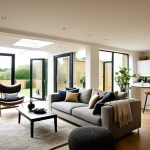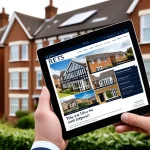How Smart Technology Improves Everyday Living in UK Homes
Smart home technology UK transforms daily life by enhancing home automation comfort through personalised and remote-controlled devices. UK homeowners increasingly prioritise convenience, energy efficiency, and security, which smart devices benefits address effectively.
Core features include automation that adjusts settings without manual input, personalisation to suit individual routines, and remote control via smartphones or voice assistants. For example, automated heating schedules can intuitively match a family’s living patterns, providing warmth on demand while saving energy. This level of customisation leads to a more comfortable and efficient home environment.
Also to discover : How is the UK addressing social inequality through policy changes?
In the UK, adoption trends reflect a growing appetite for smart devices that simplify chores and reduce utility bills. Many users appreciate how these systems integrate with existing appliances, such as boilers or lighting, to create seamless home ecosystems. Benefits like real-time monitoring and easy voice commands cater to a diverse population seeking both practical solutions and elevated comfort.
Ultimately, smart home technology UK empowers residents to tailor their living spaces with minimal effort. The ability to control and automate various functions provides not only convenience but also peace of mind—making everyday life smoother and more enjoyable. By embracing these innovations, UK homes can become smarter, more efficient, and reliably comfortable.
Have you seen this : How Are Recent UK Political Events Impacting Citizens’ Daily Lives?
Smart Thermostats and Temperature Regulation
Smart thermostats UK stand out as a cornerstone of home automation comfort by precisely regulating temperature and optimising energy use in UK homes. These devices adapt heating schedules to the occupants’ routines, often learning preferences to maintain warmth just when needed. This feature directly delivers on the key smart devices benefits of convenience and cost savings.
Integration with traditional UK central heating systems—such as boilers and radiators—is seamless. Popular smart thermostats like Hive, Nest, and Tado communicate effectively with these heating setups, providing remote control through apps and voice commands. This integration ensures rooms are heated efficiently without unnecessary waste, adjustable down to individual room temperatures.
For example, a user returning from work can remotely activate their heating to a cosy temperature, eliminating the wait for warmth and reducing energy spent heating an empty house. Moreover, smart thermostats can detect open windows or unusual temperature drops, automatically adjusting settings to maximise comfort and savings.
These capabilities address UK users’ priorities by balancing comfort with practical energy management. With rising energy costs, the smart home technology UK market increasingly favours devices that offer real monetary benefits alongside enhanced living conditions—making smart thermostats a smart, user-friendly choice for modern British households.
Advanced Lighting Solutions for Enhanced Comfort
Light shapes how we feel at home. In the UK, smart lighting UK systems deliver customised ambience while boosting home automation comfort. Automated lighting automatically adjusts brightness and colours throughout the day, matching natural outdoor light patterns or user preferences. This automation reduces the need for manual switching, which is a key smart devices benefit.
For example, smart bulbs and dimmers enable precise control of light intensity, enhancing mood and focus. Scheduling features tailor light changes to typical UK routines, such as brighter lights in the morning and softer hues for evening relaxation. This adaptability supports wellbeing while optimising energy use.
Leading products such as Philips Hue and LIFX are widely available in the UK, offering compatibility with popular voice assistants and smartphone apps. This integration enables remote control, so users can adjust lighting from anywhere, reinforcing convenience and energy efficiency.
In short, smart lighting UK transforms homes by combining automation, personalisation, and remote access. These lighting solutions not only create inviting atmospheres but also contribute to daily comfort and energy savings. This makes them a popular choice among UK households seeking both practical and atmospheric benefits from smart home technology.
Security and Peace of Mind with Smart Home Devices
Smart security UK systems significantly enhance home monitoring comfort by providing constant vigilance and immediate alerts. Key features include smart alarms equipped with motion sensors, cameras, and real-time notifications accessible remotely via smartphone apps. This enables homeowners to monitor their property from anywhere, boosting both physical security and emotional reassurance.
Remote access is crucial, allowing users to arm or disarm systems and view live footage on demand. Integration with emergency services or local police adds an extra layer of protection, linking alerts to rapid response teams when necessary. For example, smart security systems like Ring and Yale are tailored for UK homes, offering compatibility with local neighbourhood watch schemes to foster community safety.
Beyond deterring burglary, these devices contribute to everyday peace of mind by tracking unusual activities and enabling prompt intervention. The combination of automation—such as scheduled arming—and personalisation ensures systems adapt to the homeowner’s lifestyle, maximising their smart devices benefits.
UK adoption trends show rising demand for intelligent security that blends convenience with high performance. As concerns about home safety increase, smart security UK delivers a practical, technology-driven solution that integrates seamlessly with broader smart home setups, reinforcing the sense of comfort and control that modern homeowners seek.
Integrating Smart Technology with UK Utilities and Climate Needs
Smart home technology UK increasingly focuses on smart integration with local utilities to maximise energy efficiency and comfort. Devices now commonly connect with UK utility providers and smart meters, allowing households to track real-time energy consumption and adjust usage accordingly. This capability supports smarter budgeting and reduces waste—a key smart devices benefit.
UK homes face variable weather conditions, so climate-responsive tech is essential. Smart boilers and heating systems adapt to the unpredictable UK climate by monitoring external temperatures and adjusting heat output to maintain consistent warmth. This responsiveness enhances home automation comfort by ensuring rooms stay cosy without unnecessary energy use.
Renewable energy sources, such as solar panels, pair effectively with smart systems to optimise power use and storage. For example, smart home setups can prioritise solar power during peak generation and switch to grid electricity only when necessary, cutting costs and environmental impact.
Unique UK housing stock also benefits from bespoke smart solutions tailored to older buildings or flats with specific energy challenges. Overall, the fusion of smart devices with local utility systems and climate considerations empowers UK homeowners to boost comfort while embracing energy-conscious living.
How Smart Technology Improves Everyday Living in UK Homes
Smart home technology UK optimises home automation comfort primarily through three core features: automation, personalisation, and remote control. Automation allows smart devices to operate independently based on preset conditions, reducing the need for manual intervention. For instance, lighting and heating systems automatically adjust to daily routines, ensuring homes remain cosy without constant user input. Personalisation tailors settings to the preferences of different household members, enhancing comfort by adapting to individual schedules and habits. Remote control via smartphone apps or voice assistants permits users to manage devices conveniently from any location, combining flexibility with efficiency.
UK adoption trends reflect a strong preference for technologies that balance ease of use with tangible benefits. Many homeowners prioritise smart devices benefits like energy savings, convenience, and improved security. This demand encourages manufacturers to create interoperable products that integrate seamlessly with existing home infrastructure, such as boilers and smart meters. Additionally, a growing segment of the UK population values solutions that support sustainable living and align with the country’s efforts towards energy efficiency.
Ultimately, smart home technology UK empowers residents to create adaptive living environments. By combining automation, personalisation, and remote control, these innovations deliver enhanced comfort and practical advantages tailored specifically to UK lifestyles.
Accessibility, Ease of Use, and Everyday Convenience
Smart home accessibility UK focuses on making user-friendly technology widely available, ensuring all residents benefit from home automation comfort. Voice assistants like Alexa and Google Assistant simplify interaction, enabling hands-free control of smart devices. This convenience is key for users who may find traditional controls challenging, including elderly or disabled individuals.
Smartphone apps offer intuitive interfaces where users can easily set schedules, adjust settings, or receive notifications, offering control from anywhere. Automation routines further reduce effort by allowing devices to operate based on habits or environmental cues, removing the need for constant manual input. These features collectively enhance the smart devices benefits by making everyday living smoother and more adaptable.
In the UK, demand for accessible smart home tech grows with increasing awareness of its potential to improve daily routines. Manufacturers respond by designing systems that accommodate varied needs and technical comfort levels. For example, voice commands can activate lighting or heating without physical interaction, directly boosting home automation comfort for diverse households.
Overall, improved accessibility through voice control, apps, and automation empowers UK homeowners with seamless convenience. This fosters greater adoption of smart solutions, ensuring comfort and efficiency are available to a broader population without compromising ease of use.






